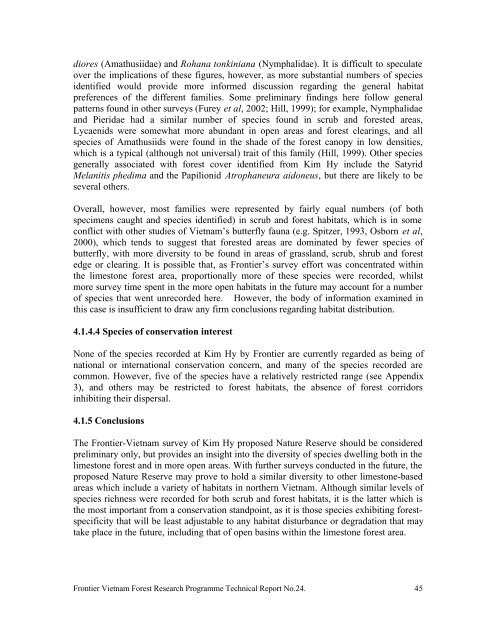Kim Hy Proposed Nature Reserve - Frontier-publications.co.uk
Kim Hy Proposed Nature Reserve - Frontier-publications.co.uk
Kim Hy Proposed Nature Reserve - Frontier-publications.co.uk
You also want an ePaper? Increase the reach of your titles
YUMPU automatically turns print PDFs into web optimized ePapers that Google loves.
diores (Amathusiidae) and Rohana tonkiniana (Nymphalidae). It is difficult to speculate<br />
over the implications of these figures, however, as more substantial numbers of species<br />
identified would provide more informed discussion regarding the general habitat<br />
preferences of the different families. Some preliminary findings here follow general<br />
patterns found in other surveys (Furey et al, 2002; Hill, 1999); for example, Nymphalidae<br />
and Pieridae had a similar number of species found in scrub and forested areas,<br />
Lycaenids were somewhat more abundant in open areas and forest clearings, and all<br />
species of Amathusiids were found in the shade of the forest canopy in low densities,<br />
which is a typical (although not universal) trait of this family (Hill, 1999). Other species<br />
generally associated with forest <strong>co</strong>ver identified from <strong>Kim</strong> <strong>Hy</strong> include the Satyrid<br />
Melanitis phedima and the Papilionid Atrophaneura aidoneus, but there are likely to be<br />
several others.<br />
Overall, however, most families were represented by fairly equal numbers (of both<br />
specimens caught and species identified) in scrub and forest habitats, which is in some<br />
<strong>co</strong>nflict with other studies of Vietnam’s butterfly fauna (e.g. Spitzer, 1993, Osborn et al,<br />
2000), which tends to suggest that forested areas are dominated by fewer species of<br />
butterfly, with more diversity to be found in areas of grassland, scrub, shrub and forest<br />
edge or clearing. It is possible that, as <strong>Frontier</strong>’s survey effort was <strong>co</strong>ncentrated within<br />
the limestone forest area, proportionally more of these species were re<strong>co</strong>rded, whilst<br />
more survey time spent in the more open habitats in the future may ac<strong>co</strong>unt for a number<br />
of species that went unre<strong>co</strong>rded here. However, the body of information examined in<br />
this case is insufficient to draw any firm <strong>co</strong>nclusions regarding habitat distribution.<br />
4.1.4.4 Species of <strong>co</strong>nservation interest<br />
None of the species re<strong>co</strong>rded at <strong>Kim</strong> <strong>Hy</strong> by <strong>Frontier</strong> are currently regarded as being of<br />
national or international <strong>co</strong>nservation <strong>co</strong>ncern, and many of the species re<strong>co</strong>rded are<br />
<strong>co</strong>mmon. However, five of the species have a relatively restricted range (see Appendix<br />
3), and others may be restricted to forest habitats, the absence of forest <strong>co</strong>rridors<br />
inhibiting their dispersal.<br />
4.1.5 Conclusions<br />
The <strong>Frontier</strong>-Vietnam survey of <strong>Kim</strong> <strong>Hy</strong> proposed <strong>Nature</strong> <strong>Reserve</strong> should be <strong>co</strong>nsidered<br />
preliminary only, but provides an insight into the diversity of species dwelling both in the<br />
limestone forest and in more open areas. With further surveys <strong>co</strong>nducted in the future, the<br />
proposed <strong>Nature</strong> <strong>Reserve</strong> may prove to hold a similar diversity to other limestone-based<br />
areas which include a variety of habitats in northern Vietnam. Although similar levels of<br />
species richness were re<strong>co</strong>rded for both scrub and forest habitats, it is the latter which is<br />
the most important from a <strong>co</strong>nservation standpoint, as it is those species exhibiting forestspecificity<br />
that will be least adjustable to any habitat disturbance or degradation that may<br />
take place in the future, including that of open basins within the limestone forest area.<br />
<strong>Frontier</strong> Vietnam Forest Research Programme Technical Report No.24. 45
















